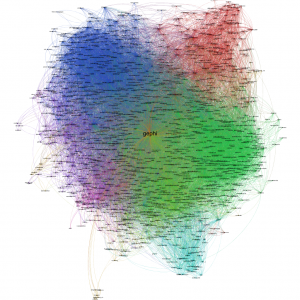Last week we established how digital marking came into the picture and we underlined some of its benefits. I concluded that for businesses to experience these benefits they start off by building Platforms. One of the Platforms is Social Networking.
Russell (2007) said “Social networking is the process of connecting entities together based on their social bonds or ties”. Online social networking started late 1973 with email, the first internet person to person network. Now we all have witness online social networking grown over the years from instant messaging to social networking website like Facebook and Twitter.
Statistics prove that social networking website has been the popular platform businesses use to engage with customers. To help understand why, we need to explore some of its benefits it gives to businesses.
Social networking websites first of all are networking sites that enable users to connect by creating personal information profiles, inviting friends and colleagues to have access to those profiles, and sending e-mails and instant messages between each other (Kaplan 2010). From this definition we can tell businesses can know consumers on a personal level via using Social networking sites. Muniz & O’Guinn (2001)point out that using Social networking website helps business with their brand creation and product or service awareness.
Let’s use my favourite movie as an example, Warner Brothers used their Facebook profile to promote the movie “The Hobbit: The Battle of the Five Armies.” This platform allowed visitors to watch trailers, download graphics, and play games. Movie critics were not pleased with the movie. However, it generated over a $1billion during its time at the box office with only $250million budget. This shows the awareness Facebook provided played a fundamental part in the film’s success.
Stelzner (2011), on other hand, throw light to other benefits of social network sites, he believes it helps business gain competitive advantage. Because it improved searching rating which leads to increased traffic /subscribers to websites, qualified leads in the long run improved sales and reduction in overall marketing expenses. One significant benefit academics over look is social networking site gives businesses platform to carry out experiential marketing (Palmer & Koenig-Lewis 2009).
Social Networking Experiential Marketing
One of the memorable social networking experiential marketing I have witness was from Oreo. Oreo created a campaign on Pinterest and facebook called the “Daily Twist” in which Oreo lovers carved the cookie into various shapes, took a picture, and pinned it to the wall. This brought the product and firm into full view of the public for the entire work day.
https://www.youtube.com/watch?v=Z1XW96QCOK8
Why is this platform so effective? Jacomy et al (2009), Graph theory will helps us understand why social networking sites are able to deliver all these benefits. They believe it’s down to its properties such as density, centrality, connectivity, bridges and holes. Take connectivity for an example, it has attributes such as reachability, long distance and high number of paths. Therefore is obvious for e-commerce businesses like Asos , Next or even your local corner shop to benefit from word of mouth.
Drawbacks
When a business or firm is using social networking, there is a big chances a third-party would facilitate abuse of the business’ trademarks and copyrights. Using social media to promote brand, products, or services can also implicate trust, privacy and data security issues. Finally, any negative post responses to marketing campaigns on social networking can tarnish a business reputation.
References
Hemanth, V. (2012). Virtual Social Vetwork and Virtual Communities.Available: <http://www.astra.iisc.ernet.in/Pages/cst-mm/t&sd-2007/Virtual%20Social%20Networking%20-%20Vishal%20Hemanth%20V.pdf>. Last (accessed 12 April 2015).
Kaplan, A. (2010). Users of the world, unite! The challenges and opportunities of Social Media. Business Horizons. 53 (1), 1-6.
Muniz, T & O’Guinn, T. (2001). Brand community. Journal of Consumer Research. 27 (1), 412–432.
Palmer, A & Koenig‐Lewis, N. . (2009). An experiential social network‐based approach to direct marketing. An International Journal. 3 (3), 162-176.
Stelzner, M. (2011). How Marketers Are Using Social Media to Grow Their Businesses. Available:<http://www.socialmediaexaminer.com/SocialMediaMarketingReport2011.pdf>. (Last accessed 12 April 2015).



